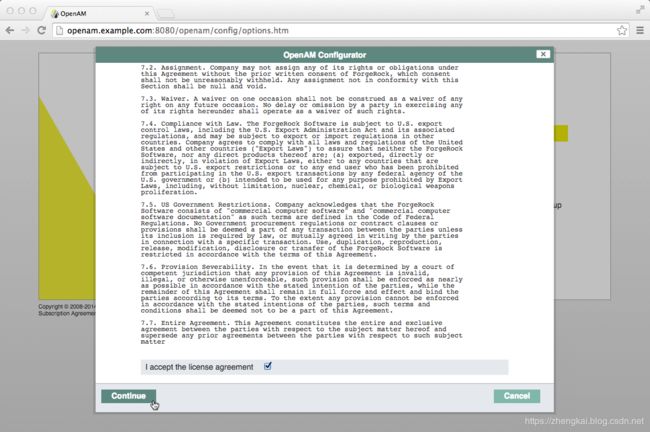- 使用OpenAM为其他应用程序配置统一身份认证
昶衿莅
使用OpenAM为其他应用程序配置统一身份认证一、前言废话ArcGISPortal软件中内置了支持SAML协议,可以实现与OpenAM同步用户权限的深度集成。对于不支持SAML的web应用,我们使用代理的方式进行表象集成,人为将该应用系统的用户信息在OpenAM中建立,在登录系统时跳转OpenAM登录界面,输入用户信息后跳转回web应用系统。本文中使用的web服务器为IIS10二、配置方式1、安装
- angular发post命令,使用表单形式
价值投机168
使用方法:consts="CMD数据";consthttpHeader={headers:newHttpHeaders({'Content-Type':'application/x-www-form-urlencoded','origin':'http://openam.example.com:8080'})};this.httpPost(s.SSOUrl,{name:'SAMLRequest',
- 单点CAS(杂记)
程序员
最近对单点系统进行了一点了解。公司以前单点系统用的是openam。相比CAS,存在着配置太固定化,只能按照openam自身约束的来,二次开发不容易。而CAS只提供了基本的功能,剩余的修改密码、新建等都需要自己写,从而提供了很大的灵活性。现有一个项目需要设计一套单点系统,设计思路如下:1、数据整合和初始同步1)梳理现有两个数据库的信息,包括现有数据容量、数据库字段、数据库配置等信息2)根据现有的数据
- OpenAM实现ArcGIS Portal统一身份认证(一)--OpenAM安装
昶衿莅
OpenAM与ArcGISPortal联合实现统一身份认证(一)--OpenAM安装一、前言废话OpenAM是一款身份认证软件,可以实现不同的web系统的统一的身份认证。在业务开展过程中我们经常会使用多个系统来完成一项事情。如你在每周五下班前需要填写本周工作总结和下周工作计划,搞定本周的报销然后打卡下班。这时候你就需要财务系统,工时系统和打卡系统。也就是说你需要登录三个系统,很可能你会有三个不同的
- OpenAM实现ArcGIS Portal统一身份认证(二)--联合Portal
昶衿莅
OpenAM实现ArcGISPortal统一身份认证(二)--联合Portal1.在浏览器中输入OpenAM访问地址(协议+机器全名+端口+OpenAM包名),以管理员身份登录。截图1:OpenAM登录2.登录完成后,点击创建托管身份认证提供者。截图2选择创建托管身份认证提供者3.配置签名密码,新建信任环,点击配置。此处签名密码为test信任环为vvv。截图3:配置签名密码和信任环4.完成身份认证
- OpenAM之SAML2配置
一颗桃子t
What’sSAML2SAML是安全断言标记语言(英语:SecurityAssertionMarkupLanguage,简称SAML,发音sam-el),一种xml格式的语言。有两个点:第一是安全(Security),第二是断言(assertion)。先看它的核心概念断言(assertion)。断言是什么?就是做出判断的语言。比如一个例子:小红没有权限读取根目录。这就是一个断言。这种“做出判断的语
- OpenAM之OAuth2配置
一颗桃子t
OpenAMOAuth2OpenAM是很强大的,OAuth2的配置也相对简单,分3步走配置OAuth2Application(=OAuth2connectclient/≈OAuth2agent)配置OAuth2ServiceProvider(ConfigureOAuth2authorizationserver)验证OAuth2的code/access_token/tokeninfo是否正确配置OA
- OpenAM文档之Authentication and Single Sign-On Guide Chapter 1. Introduction
一颗桃子t
Chapter1.IntroducingAuthenticationandSingleSign-On翻译byhttps://zhengkai.blog.csdn.net原文athttps://backstage.forgerock.com/docs/am/5.1/authentication-guide/index.html#chap-authn-introduction-authn身份验证是验证
- OpenAM单点登录系统安装部署手册
一颗桃子t
OpenAM简介OpenAM是一个开源的访问管理、授权服务平台。由ForegeRock公司发起。OpenAM前身为OpenSSO,由SUN公司创建,Oracle关闭OpenSSO后,OpenAM成为其继续者。OpenAM将“控制访问”(accesscontrol)实现聚焦在处理验证(authentication)和授权(authorization)两个方面。“验证”是对个体身份的鉴别,例如,验证用
- 基于OpenAM系列的SSO----基础
一颗桃子t
基于OpenAM系列的SSO----基础OpenAM简介:OpenAM是一个开源的访问管理、授权服务平台。由ForegeRock公司发起。OpenAM前身为OpenSSO,由SUN公司创建,现在属于Oracle。本文在OpenAM13版的GettingstartedWithOpenAM文档上进行描述和总结。在这个文档中你将了解如何使用OpenAM和Web策略代理(policyagent)来管理一个
- Linux中ROOT用户删除普通用户报普通用户已登录
金士顿
linx
原文链接:https://blog.csdn.net/mooncom/article/details/62236633问题产生背景:今天在Linux某普通用户openam_jxedu上配置系统,因为文件误删,我想删除系统安装文件,重新解压安装,但是考虑到该系统生成的配置文件可能会对后来的某些功能造成影响,因此便想删除该普通用户——openam_jxedu,然后重新创建该用户,然后再进行系统的重新安
- OpenAM单点登录系统安装部署手册
Moshow郑锴
OpenAM
OpenAM简介OpenAM是一个开源的访问管理、授权服务平台。由ForegeRock公司发起。OpenAM前身为OpenSSO,由SUN公司创建,Oracle关闭OpenSSO后,OpenAM成为其继续者。OpenAM将“控制访问”(accesscontrol)实现聚焦在处理验证(authentication)和授权(authorization)两个方面。“验证”是对个体身份的鉴别,例如,验证用
- OPENAM使用小结2
低垂的风吹
javasso单点登录
部署好OPENAM之后,它默认会有一个密钥库,这时你要创建自己的密钥库及加密密码:1.创建一个文件夹,cd进去文件夹后,执行下列命令(使用java自带的keytool工具,):keytool-genkeypair-aliasmykey-keyalgRSA-keysize1024-validity365-storetypeJKS-keystorekeystore.jks在创建的过程中,你会输入密钥库
- 解决Linux中ROOT用户删除普通用户报普通用户已登录问题
霜月枫桥
问题产生背景:今天在Linux某普通用户openam_jxedu上配置系统,因为文件误删,我想删除系统安装文件,重新解压安装,但是考虑到该系统生成的配置文件可能会对后来的某些功能造成影响,因此便想删除该普通用户――openam_jxedu,然后重新创建该用户,然后再进行系统的重新安装。问题描述:我在root用户下,使用userdel-ropenam_jxedu指令删除该用户,但是却发现报如下错误。
- Linux中ROOT用户删除普通用户报普通用户已登录
霜月枫桥
Linux开发
问题产生背景:今天在Linux某普通用户openam_jxedu上配置系统,因为文件误删,我想删除系统安装文件,重新解压安装,但是考虑到该系统生成的配置文件可能会对后来的某些功能造成影响,因此便想删除该普通用户——openam_jxedu,然后重新创建该用户,然后再进行系统的重新安装。问题描述:我在root用户下,使用userdel-ropenam_jxedu指令删除该用户,但是却发现报如下错误。
- Linux中ROOT用户删除普通用户报普通用户已登录
霜月枫桥
Linux开发
问题产生背景:今天在Linux某普通用户openam_jxedu上配置系统,因为文件误删,我想删除系统安装文件,重新解压安装,但是考虑到该系统生成的配置文件可能会对后来的某些功能造成影响,因此便想删除该普通用户——openam_jxedu,然后重新创建该用户,然后再进行系统的重新安装。问题描述:我在root用户下,使用userdel-ropenam_jxedu指令删除该用户,但是却发现报如下错误。
- CentOS 安装 OpenAM
rensanning
阅读更多官网:https://forgerock.org/openam/注意事项:关闭SELinux、IPv6、防火墙。OpenAM需要很大的内存建议最低2GB。OpenAM内置的OpenDJ需要64K的FileDescriptor。OpenAM的所有处理是基于domain的Cookie做的,所以不能通过localhost或IP来访问。CookieDomain必须以点开头,比如".example.
- CentOS 安装 OpenAM
rensanning
阅读更多官网:https://forgerock.org/openam/注意事项:关闭SELinux、IPv6、防火墙。OpenAM需要很大的内存建议最低2GB。OpenAM内置的OpenDJ需要64K的FileDescriptor。OpenAM的所有处理是基于domain的Cookie做的,所以不能通过localhost或IP来访问。CookieDomain必须以点开头,比如".example.
- CentOS 安装 OpenAM
rensanning
阅读更多官网:https://forgerock.org/openam/注意事项:关闭SELinux、IPv6、防火墙。OpenAM需要很大的内存建议最低2GB。OpenAM内置的OpenDJ需要64K的FileDescriptor。OpenAM的所有处理是基于domain的Cookie做的,所以不能通过localhost或IP来访问。CookieDomain必须以点开头,比如".example.
- CAS4.0版本restful API部署及调用(http版)
equalxx
casserver4.0javarestful部署配置
阅读更多最近刚开始做后台,有很多知识亟需补充。几个平台要统一登录接口,由于投资方的系统使用CAS进行单点登录,我们也只能部署cas。架构师表示有很多比CAS更好的框架,比如openAM之类的。结果从网上搜到的看起来貌似官方的教程略不靠谱,很多网站的教程还都是3.n的版本号,里面getticket时候需要com.noelios.restlet的包,尼玛至少4.0已经不需要这些包了,把它们配置进去是不
- CAS4.0版本restful API部署及调用(http版)
equalxx
casserver4.0javarestful部署配置
阅读更多最近刚开始做后台,有很多知识亟需补充。几个平台要统一登录接口,由于投资方的系统使用CAS进行单点登录,我们也只能部署cas。架构师表示有很多比CAS更好的框架,比如openAM之类的。结果从网上搜到的看起来貌似官方的教程略不靠谱,很多网站的教程还都是3.n的版本号,里面getticket时候需要com.noelios.restlet的包,尼玛至少4.0已经不需要这些包了,把它们配置进去是不
- Ubuntu 安装配置opendj + openam
fxismonk
linux
1.Installtomcat7sudoapt-getinstalltomcat7tomcat7-admin2.Addatomcatmanageusersudovi/etc/tomcat7/tomcat-users.xmlAddthefollowingdatapiece:3.Increaseuploadsizesudovi/usr/share/tomcat7-admin/manager/WEB-I
- openAM安装
u014426603
不了解openAm是干什么的,上来就用的同学可以看一下这篇博客http://blog.sina.com.cn/s/blog_6ab9a9dc01019q38.html根据openAM-13的release-note,我选择的最新版本搭配环境为centos7.2,tamcat8,javajdk8,现在openAM为forgeRock公司所有,https://www.forgerock.com.上面有
- SAML : A SAML stack
stack
http://nzpcmad.blogspot.co.nz/2013/06/saml-saml-stack.html
You have an application – .NET, JAVA whatever. You want this to be a SP and need to connect to an IDP – ADFS, OpenAM, simpleSAMLPHP … Look a
- 利用Flashbug插件查看AMF数据
Flash
一、什么是AMF
AMF是Flash与服务器进行通信的一种编码格式(为了方便理解,你可以暂时把它理解为与XML相似的技术),但它是以二进制数据进行传输的,客户端采用POST形式进行数据提交,它的最大特色是可以直接传输复杂的数据类型,比如数组、普通对象、日期对象等,而且可以对传输的数据进行压缩以提高传输速率,另外结合Flash Remoting网关(FluorineFx、amfphp、OpenAM
- OPenAM(OPenSSO)URL POST请求
rongyongfeikai2
环境如下:机器A:Tomcat运行了OpenAM,保护其Apache服务器配置的WEB项目,Apache配置了Agent。WEB项目是用PHP写的,已经开启了跨域访问,即配置了:header("Access-Control-Allow-Origin:*");header("Access-Control-Allow-Headers:*");header("Access-Control-Allow-M
- Windows下OpenAM的配置
rongyongfeikai2
在一台Windows7系统的机器上进行OpenAM的配置。该机器上已经安装了JDK、Apache2.2、Tomcat。1.首先配置机器的host文件,配置如下(C:\Windows\System32\drivers\etc\host):127.0.0.1localhostopenam.example.comwww.example.com2.将openam_10.0.1.zip解压缩,将其中的ope
- OpenAM-页面修改
love297
open
OpenAM中内置登录相关的页面,放到我们自己的系统中必须做修改。
OpenAM的登录页面路径:\webapp\config\auth\default
中文平台路径:\webapp\config\auth\default_ZH_CN
页
- OpenAM-配置细节记录
love297
open
1.客户端AmConfig.properties中配置
com.sun.identity.agents.app.username=UrlAccessAgent
com.iplanet.am.service.password=
如果不配置,或配置错误会产生下面错误信息:
com.iplanet.sso.SSOException: AdminTokenAction:
- OpenAM-添加支持PUT/DELETE请求
love297
delete
1.在openam服务器发布之前修改配置文件/WEB-INF/class/amWebAgent.xml 和 amWebAgent.properties 添加PUT 和 DELETE 支持 (复制上面的GET,修改即可)
2.修改代理tomcat web.xml配置文件,在org.apache.catalina.servlets.DefaultServlet 下面添加参数:readonl
- 继之前的线程循环加到窗口中运行
3213213333332132
javathreadJFrameJPanel
之前写了有关java线程的循环执行和结束,因为想制作成exe文件,想把执行的效果加到窗口上,所以就结合了JFrame和JPanel写了这个程序,这里直接贴出代码,在窗口上运行的效果下面有附图。
package thread;
import java.awt.Graphics;
import java.text.SimpleDateFormat;
import java.util
- linux 常用命令
BlueSkator
linux命令
1.grep
相信这个命令可以说是大家最常用的命令之一了。尤其是查询生产环境的日志,这个命令绝对是必不可少的。
但之前总是习惯于使用 (grep -n 关键字 文件名 )查出关键字以及该关键字所在的行数,然后再用 (sed -n '100,200p' 文件名),去查出该关键字之后的日志内容。
但其实还有更简便的办法,就是用(grep -B n、-A n、-C n 关键
- php heredoc原文档和nowdoc语法
dcj3sjt126com
PHPheredocnowdoc
<!doctype html>
<html lang="en">
<head>
<meta charset="utf-8">
<title>Current To-Do List</title>
</head>
<body>
<?
- overflow的属性
周华华
JavaScript
<!DOCTYPE html PUBLIC "-//W3C//DTD XHTML 1.0 Transitional//EN" "http://www.w3.org/TR/xhtml1/DTD/xhtml1-transitional.dtd">
<html xmlns="http://www.w3.org/1999/xhtml&q
- 《我所了解的Java》——总体目录
g21121
java
准备用一年左右时间写一个系列的文章《我所了解的Java》,目录及内容会不断完善及调整。
在编写相关内容时难免出现笔误、代码无法执行、名词理解错误等,请大家及时指出,我会第一时间更正。
&n
- [简单]docx4j常用方法小结
53873039oycg
docx
本代码基于docx4j-3.2.0,在office word 2007上测试通过。代码如下:
import java.io.File;
import java.io.FileInputStream;
import ja
- Spring配置学习
云端月影
spring配置
首先来看一个标准的Spring配置文件 applicationContext.xml
<?xml version="1.0" encoding="UTF-8"?>
<beans xmlns="http://www.springframework.org/schema/beans"
xmlns:xsi=&q
- Java新手入门的30个基本概念三
aijuans
java新手java 入门
17.Java中的每一个类都是从Object类扩展而来的。 18.object类中的equal和toString方法。 equal用于测试一个对象是否同另一个对象相等。 toString返回一个代表该对象的字符串,几乎每一个类都会重载该方法,以便返回当前状态的正确表示.(toString 方法是一个很重要的方法) 19.通用编程:任何类类型的所有值都可以同object类性的变量来代替。
- 《2008 IBM Rational 软件开发高峰论坛会议》小记
antonyup_2006
软件测试敏捷开发项目管理IBM活动
我一直想写些总结,用于交流和备忘,然都没提笔,今以一篇参加活动的感受小记开个头,呵呵!
其实参加《2008 IBM Rational 软件开发高峰论坛会议》是9月4号,那天刚好调休.但接着项目颇为忙,所以今天在中秋佳节的假期里整理了下.
参加这次活动是一个朋友给的一个邀请书,才知道有这样的一个活动,虽然现在项目暂时没用到IBM的解决方案,但觉的参与这样一个活动可以拓宽下视野和相关知识.
- PL/SQL的过程编程,异常,声明变量,PL/SQL块
百合不是茶
PL/SQL的过程编程异常PL/SQL块声明变量
PL/SQL;
过程;
符号;
变量;
PL/SQL块;
输出;
异常;
PL/SQL 是过程语言(Procedural Language)与结构化查询语言(SQL)结合而成的编程语言PL/SQL 是对 SQL 的扩展,sql的执行时每次都要写操作
- Mockito(三)--完整功能介绍
bijian1013
持续集成mockito单元测试
mockito官网:http://code.google.com/p/mockito/,打开documentation可以看到官方最新的文档资料。
一.使用mockito验证行为
//首先要import Mockito
import static org.mockito.Mockito.*;
//mo
- 精通Oracle10编程SQL(8)使用复合数据类型
bijian1013
oracle数据库plsql
/*
*使用复合数据类型
*/
--PL/SQL记录
--定义PL/SQL记录
--自定义PL/SQL记录
DECLARE
TYPE emp_record_type IS RECORD(
name emp.ename%TYPE,
salary emp.sal%TYPE,
dno emp.deptno%TYPE
);
emp_
- 【Linux常用命令一】grep命令
bit1129
Linux常用命令
grep命令格式
grep [option] pattern [file-list]
grep命令用于在指定的文件(一个或者多个,file-list)中查找包含模式串(pattern)的行,[option]用于控制grep命令的查找方式。
pattern可以是普通字符串,也可以是正则表达式,当查找的字符串包含正则表达式字符或者特
- mybatis3入门学习笔记
白糖_
sqlibatisqqjdbc配置管理
MyBatis 的前身就是iBatis,是一个数据持久层(ORM)框架。 MyBatis 是支持普通 SQL 查询,存储过程和高级映射的优秀持久层框架。MyBatis对JDBC进行了一次很浅的封装。
以前也学过iBatis,因为MyBatis是iBatis的升级版本,最初以为改动应该不大,实际结果是MyBatis对配置文件进行了一些大的改动,使整个框架更加方便人性化。
- Linux 命令神器:lsof 入门
ronin47
lsof
lsof是系统管理/安全的尤伯工具。我大多数时候用它来从系统获得与网络连接相关的信息,但那只是这个强大而又鲜为人知的应用的第一步。将这个工具称之为lsof真实名副其实,因为它是指“列出打开文件(lists openfiles)”。而有一点要切记,在Unix中一切(包括网络套接口)都是文件。
有趣的是,lsof也是有着最多
- java实现两个大数相加,可能存在溢出。
bylijinnan
java实现
import java.math.BigInteger;
import java.util.regex.Matcher;
import java.util.regex.Pattern;
public class BigIntegerAddition {
/**
* 题目:java实现两个大数相加,可能存在溢出。
* 如123456789 + 987654321
- Kettle学习资料分享,附大神用Kettle的一套流程完成对整个数据库迁移方法
Kai_Ge
Kettle
Kettle学习资料分享
Kettle 3.2 使用说明书
目录
概述..........................................................................................................................................7
1.Kettle 资源库管
- [货币与金融]钢之炼金术士
comsci
金融
自古以来,都有一些人在从事炼金术的工作.........但是很少有成功的
那么随着人类在理论物理和工程物理上面取得的一些突破性进展......
炼金术这个古老
- Toast原来也可以多样化
dai_lm
androidtoast
Style 1: 默认
Toast def = Toast.makeText(this, "default", Toast.LENGTH_SHORT);
def.show();
Style 2: 顶部显示
Toast top = Toast.makeText(this, "top", Toast.LENGTH_SHORT);
t
- java数据计算的几种解决方法3
datamachine
javahadoopibatisr-languer
4、iBatis
简单敏捷因此强大的数据计算层。和Hibernate不同,它鼓励写SQL,所以学习成本最低。同时它用最小的代价实现了计算脚本和JAVA代码的解耦,只用20%的代价就实现了hibernate 80%的功能,没实现的20%是计算脚本和数据库的解耦。
复杂计算环境是它的弱项,比如:分布式计算、复杂计算、非数据
- 向网页中插入透明Flash的方法和技巧
dcj3sjt126com
htmlWebFlash
将
Flash 作品插入网页的时候,我们有时候会需要将它设为透明,有时候我们需要在Flash的背面插入一些漂亮的图片,搭配出漂亮的效果……下面我们介绍一些将Flash插入网页中的一些透明的设置技巧。
一、Swf透明、无坐标控制 首先教大家最简单的插入Flash的代码,透明,无坐标控制: 注意wmode="transparent"是控制Flash是否透明
- ios UICollectionView的使用
dcj3sjt126com
UICollectionView的使用有两种方法,一种是继承UICollectionViewController,这个Controller会自带一个UICollectionView;另外一种是作为一个视图放在普通的UIViewController里面。
个人更喜欢第二种。下面采用第二种方式简单介绍一下UICollectionView的使用。
1.UIViewController实现委托,代码如
- Eos平台java公共逻辑
蕃薯耀
Eos平台java公共逻辑Eos平台java公共逻辑
Eos平台java公共逻辑
>>>>>>>>>>>>>>>>>>>>>>>>>>>>>>>>>>>>>>>
蕃薯耀 2015年6月1日 17:20:4
- SpringMVC4零配置--Web上下文配置【MvcConfig】
hanqunfeng
springmvc4
与SpringSecurity的配置类似,spring同样为我们提供了一个实现类WebMvcConfigurationSupport和一个注解@EnableWebMvc以帮助我们减少bean的声明。
applicationContext-MvcConfig.xml
<!-- 启用注解,并定义组件查找规则 ,mvc层只负责扫描@Controller -->
<
- 解决ie和其他浏览器poi下载excel文件名乱码
jackyrong
Excel
使用poi,做传统的excel导出,然后想在浏览器中,让用户选择另存为,保存用户下载的xls文件,这个时候,可能的是在ie下出现乱码(ie,9,10,11),但在firefox,chrome下没乱码,
因此必须综合判断,编写一个工具类:
/**
*
* @Title: pro
- 挥洒泪水的青春
lampcy
编程生活程序员
2015年2月28日,我辞职了,离开了相处一年的触控,转过身--挥洒掉泪水,毅然来到了兄弟连,背负着许多的不解、质疑——”你一个零基础、脑子又不聪明的人,还敢跨行业,选择Unity3D?“,”真是不自量力••••••“,”真是初生牛犊不怕虎•••••“,••••••我只是淡淡一笑,拎着行李----坐上了通向挥洒泪水的青春之地——兄弟连!
这就是我青春的分割线,不后悔,只会去用泪水浇灌——已经来到
- 稳增长之中国股市两点意见-----严控做空,建立涨跌停版停牌重组机制
nannan408
对于股市,我们国家的监管还是有点拼的,但始终拼不过飞流直下的恐慌,为什么呢?
笔者首先支持股市的监管。对于股市越管越荡的现象,笔者认为首先是做空力量超过了股市自身的升力,并且对于跌停停牌重组的快速反应还没建立好,上市公司对于股价下跌没有很好的利好支撑。
我们来看美国和香港是怎么应对股灾的。美国是靠禁止重要股票做空,在
- 动态设置iframe高度(iframe高度自适应)
Rainbow702
JavaScriptiframecontentDocument高度自适应局部刷新
如果需要对画面中的部分区域作局部刷新,大家可能都会想到使用ajax。
但有些情况下,须使用在页面中嵌入一个iframe来作局部刷新。
对于使用iframe的情况,发现有一个问题,就是iframe中的页面的高度可能会很高,但是外面页面并不会被iframe内部页面给撑开,如下面的结构:
<div id="content">
<div id=&quo
- 用Rapael做图表
tntxia
rap
function drawReport(paper,attr,data){
var width = attr.width;
var height = attr.height;
var max = 0;
&nbs
- HTML5 bootstrap2网页兼容(支持IE10以下)
xiaoluode
html5bootstrap
<!DOCTYPE html>
<html>
<head lang="zh-CN">
<meta charset="UTF-8">
<meta http-equiv="X-UA-Compatible" content="IE=edge">






